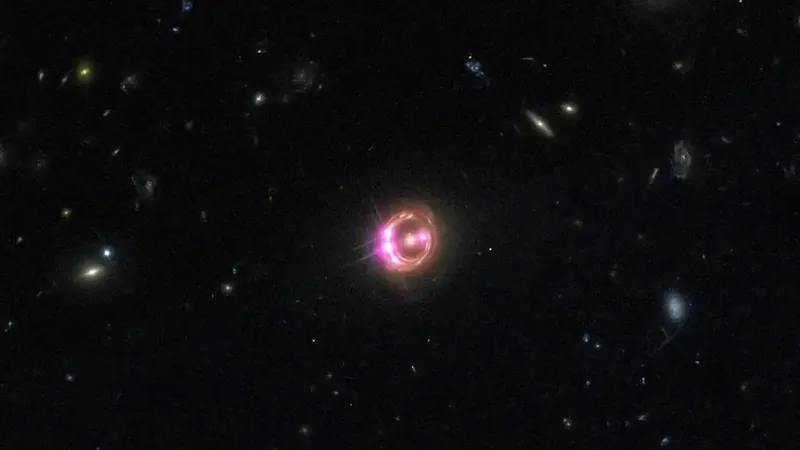
Astronomers Unveil Unprecedented Ultrapowerful Shockwave Surrounding a Black Hole!
2025-09-12
Author: Wei
In a groundbreaking revelation, astronomers have caught a glimpse of the fiery "corona" enveloping a black hole, unveiling insights into one of the universe's most enigmatic phenomena.
Located approximately 6 billion light-years from Earth, the supermassive black hole, RX J1131, spins at dizzying speeds—more than half the speed of light! Its immense gravitational pull sucks in nearby gas and dust, heating them to millions of degrees and shining bright as a quasar, one of the most dazzling entities known in the cosmos. Surrounding this black hole is its expanding corona, a halo of scorching gas measuring around 50 astronomical units, roughly equivalent to the span of our entire solar system.
A Cosmic Alignment Like No Other!
This remarkable measurement was achieved through an extraordinary cosmic alignment involving a massive foreground galaxy—located about 4 billion light-years from us. This galaxy acted as a pair of cosmic magnifying glasses, creating a stunning "double zoom" effect that allowed researchers to dissect the black hole's immediate environment in unprecedented detail.
Matus Rybak, a key researcher from Leiden University in the Netherlands, highlighted the significance of this discovery: "This is the first time such a measurement has been made; we’ve devised a novel approach to investigating phenomena occurring close to black holes."
Discovering the Secrets of Flickering Light!
The foreground galaxy’s colossal gravitational force distorted and enhanced the light from RX J1131, resulting in four distinct images of this quasar, a phenomenon known as strong gravitational lensing. After revisiting a decade-old dataset from the Atacama Large Millimeter/submillimeter Array (ALMA) in Chile, Rybak and his team observed unexpected variations in brightness among these images.
"Within a few days of analyzing the data, we thought, 'This does not look right,'" Rybak shared. "Even though it wasn't my primary research area, we couldn't resist digging deeper." Typically, if the brightness changes were emanating from the black hole, all images would fluctuate in unison. However, subsequent observations in 2022 unveiled that each image flickered in isolation.
This led to the groundbreaking conclusion that the source of the variations was microlensing. Stars in the foreground galaxy acted as tiny lenses, momentarily magnifying different sections of the corona. By analyzing these flickers, they successfully mapped out the breadth of the corona for the first time.
A Window to Understanding Black Hole Growth!
The implications of this study are monumental, providing a fresh perspective on the magnetic fields enveloping black holes. Previous studies suggested that these magnetic forces control the inflow of gas and the expulsion of energy, influencing the black hole’s growth over time. Although measuring these fields directly has been challenging, theoretical frameworks hint at a correlation between the corona's emissions, its dimensions, and the intensity of magnetic fields.
Rybak noted, "Understanding how these black holes expand is where the real potential lies." The findings are particularly striking, as it was long believed that millimeter-wave light remained static over extended periods. However, this research revealed dynamic changes, sparking excitement in the astronomical community.
What Lies Ahead for Black Hole Research?
To further explore this phenomenon, the team aspires to use data from NASA's Chandra X-ray Observatory. However, proposed budget cuts threaten the telescope's future operations. Instead, astronomers may lean on ALMA, which is entering new frequency bands where black hole coronas emit their brightest signals.
In tandem, the new Vera C. Rubin Observatory is set to excel in high-resolution optical imaging, poised to uncover vast new systems of lensed quasars like RX J1131. Rybak emphasized, "Rubin is poised to be a revolutionary instrument for these studies."
With increasingly advanced telescopes, astronomers are on the brink of uncovering the countless mysteries hidden in the millimeter-wave universe. Rybak excitedly remarked, "The thrilling part is exploring the unknown!"





 Brasil (PT)
Brasil (PT)
 Canada (EN)
Canada (EN)
 Chile (ES)
Chile (ES)
 Česko (CS)
Česko (CS)
 대한민국 (KO)
대한민국 (KO)
 España (ES)
España (ES)
 France (FR)
France (FR)
 Hong Kong (EN)
Hong Kong (EN)
 Italia (IT)
Italia (IT)
 日本 (JA)
日本 (JA)
 Magyarország (HU)
Magyarország (HU)
 Norge (NO)
Norge (NO)
 Polska (PL)
Polska (PL)
 Schweiz (DE)
Schweiz (DE)
 Singapore (EN)
Singapore (EN)
 Sverige (SV)
Sverige (SV)
 Suomi (FI)
Suomi (FI)
 Türkiye (TR)
Türkiye (TR)
 الإمارات العربية المتحدة (AR)
الإمارات العربية المتحدة (AR)